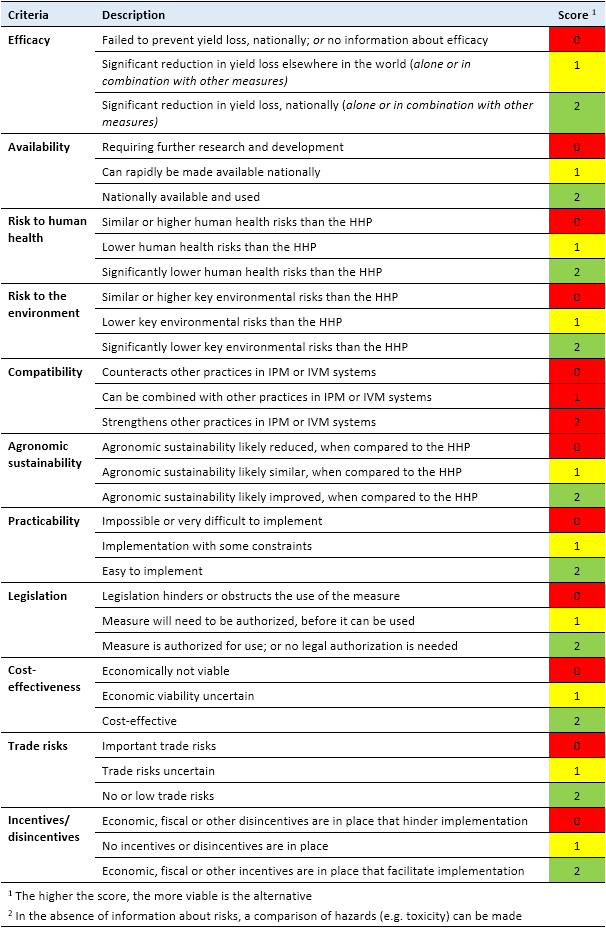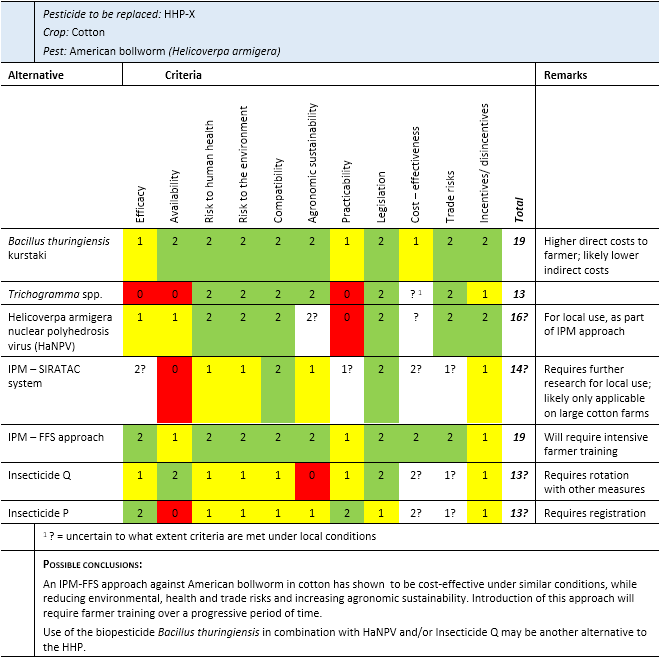Step 4. Compare alternatives and identify viable options
Purpose
This step aims at comparing potential alternatives for selected crop–pest combinations.
Evaluation criteria
Potential alternatives are compared and evaluated against a set of criteria to identify the most promising options. The criteria to be used in this step should be deliberated with national stakeholders and technical experts and be relevant to the country situation and needs.
Examples of criteria that can be used to compare alternatives and assess their viability are shown below. Note that this list is not exhaustive and relevant additional or other criteria can be identified!
- Efficacy, for controlling the target pest. The efficacy of different pest management measures can be difficult to compare and it is important to evaluate efficacy beyond simple mortality rates of a pest, especially if a measure is used as part of IPM/IVM
- Availability, or time needed for the alternative to be available locally
- Risk to human health, including occupational risks and dietary risks, and the need for and availability of PPE
- Risk to the environment, covering key national environmental priorities
- Compatibility, i.e. how good can alternatives be combined with other practices in an IPM or IVM system.
- Agronomic sustainability,g. with regard to the likelihood of resistance development, potential synergies or trade-offs with pollination services, pest resurgence or secondary pest development
- Practicability, e. technical feasibility or ease of implementation by farmers
- Legislation, i.e. whether the measure is legally authorized in the country
- Cost-effectiveness, considering direct and indirect costs, where possible
- Trade risks, in particular pesticide residues, for export commodities
- Incentives/disincentives , i.e. whether there are economic, fiscal or other incentives or disincentives in place that can either facilitate or hinder the implementation of the measure
To facilitate comparisons, a semi-quantitative scoring system can be applied. The table below provides an example of such a scoring system, where (in a very approximate way) higher scores represent alternatives that are more viable under local conditions of use. However, if a scoring system is used, it should always be discussed and adapted, based on national priorities and requirements.

Procedures
- The review of alternatives is best done through a consultative and consensual process with all key stakeholders and independent experts.
- Before recommending the registration of new pesticide products, it is important to consider which comparative advantages the new pesticide has over the already registered products for that use, or over other management practices.
- A single “golden bullet” solution will rarely exist. A combination of measures will often need to be considered.
Example summary
of the comparison of potential alternatives for HHP-X, for a priority crop-pest combination, in a hypothetical country

Additional studies
When comparing alternatives and identifying viable options, data may be missing to come to an informed conclusion. Additional studies may then need to be commissioned at the national or regional level.
Outcome of Step 4
A list of viable alternatives to the HHP in the prioritized crop-pest combination(s)
